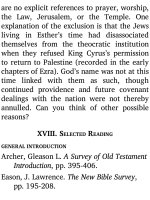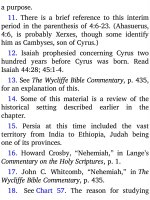Jensens survey of the old testament adam 259
Bạn đang xem bản rút gọn của tài liệu. Xem và tải ngay bản đầy đủ của tài liệu tại đây (79.73 KB, 4 trang )
since there is no reference in the book to
Josiah’s reform of 622 B.C. (For example, the
idolatrous practices condemned in 1:3-6
were dealt with in the reforms.)
5. Josiah’s reforms. At age twenty, Josiah
began a six-year program of national reform
(2 Chron 34:3), which was completed in 622
B.C. (2 Chron 34:8). Read 2 Chronicles 34-35
or 2 Kings 22-23. The sins which Zephaniah
condemns in his book were the sins over
which Josiah lamented.
6. Fall of Jerusalem (586 B.C.). Zephaniah
prophesied judgments for Jerusalem, the
rst destruction coming about a half century
later. His prophecies also referred to
judgments of succeeding centuries up to the
last days. (This is an example of multiple
prophecy, commonly found in the Old
Testament.)
7. Restoration (536 B.C. and later).
Zephaniah also prophesied restoration of the
chosen nation of God’s people. This was
ful lled, at least in token measure, when
God led His people back to the land at the
end of the Babylonian Captivity. But the full
measure of restoration is yet to be. (This is
another example of multiple prophecy.)
8. Final “day of the LORD.” The end-time
judgments of the Day of the Lord will usher
in the Messianic Kingdom (Millennium),
when Zephaniah’s prophecies of restoration
will be ful lled on a grand and total scale.
Recall that the “day of the LORD” was a
prominent subject of Joel’s prophecy.
Be sure you are well acquainted with the
previous eight points before moving on to
the survey of the Bible text.
II. SURVEY
1. First, mark the following paragraph
divisions in your Bible: 1:1,2,7,14;
2:1,4,8,12; 3:1,8,14.
2. Earlier in your study you scanned the
three chapters of Zephaniah. Now, with
pencil in hand, read the book once or twice
more, underlining key words and phrases as
you read. What repeated phrases strike you
as very prominent in this book?
3. What is Zephaniah’s message mainly
about? Compare the opening verses (1:2-6)
with the closing ones (3:14-20).
4. Refer to the survey Chart 111 as you
follow the study suggestions given below.
Read all the Bible references in your Bible.
Try to justify the chart’s outlines by the text
of the Bible.
5. What is the function of the opening
verse (1:1)?
6. How many main divisions in the book
does the chart show? Mark your Bible to
show the new divisions beginning at 2:4 and
3:8.
7. The title of the chart re ects the
keynote of Zephaniah. Read the two key
verses cited on the chart. What two outlines
develop the subject of the Day of the Lord?
What does this tell you about the day? (The
word “day” in the phrase “day of the LORD”
does not refer to a twenty-four-hour solar
day. Rather, it is an extended period of time,
whether weeks, months, or even years.)
8. How much of the prophecy deals with
Judah? How much deals with Gentile
nations?
9. What makes possible a day of
deliverance in Zephaniah’s prophecy?
Observe the function of 2:1-3 as shown on
the chart.
10. Compare your answer for question 9
with the conditions a sinner today must









